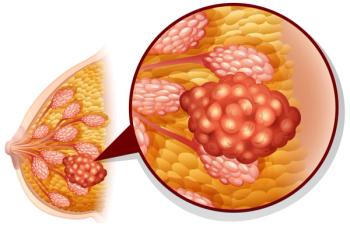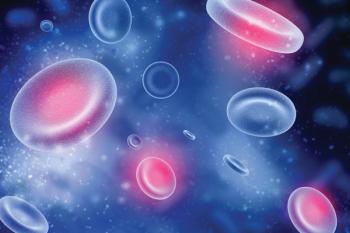
Luspatercept Meets Primary End Point of Transfusion Independence in MDS
Luspatercept may lead to a paradigm shift in the treatment of patients with lower-risk myelodysplastic syndrome, according to an expert from The University of Texas MD Anderson Cancer Center.
Findings from the phase 3 COMMANDS trial (NCT03682536) indicated that treatment with luspatercept-aamt (Reblozyl) yielded a higher rate of sustained transfusion independence compared with erythropoiesis stimulating agents (ESAs) for those with ESA-naïve, lower-risk myelodysplastic syndrome (MDS), according to research presented as part of a press briefing prior to the
In the intention-to-treat population, 58.5% of patients who received luspatercept achieved transfusion independence for at least 12 weeks with hemoglobin increase of at least 1.5 g/dL compared with 31.2% of patients who received epoetin alfa, meeting the primary end point of the study (P < .0001).
“Luspatercept is the first and only therapy to demonstrate superiority in a head-to-head study against ESAs in transfusion-dependent lower-risk MDS, [and this should be] considered a paradigm shift in the treatment of lower-risk MDS–associated anemia,” Guillermo Garcia-Manero, MD, lead study author and professor in the Department of Leukemia at The University of Texas MD Anderson Cancer Center in Houston, said in a presentation of the data.
Anemia is one of the main symptom burdens for patients with MDS, and chronic anemia and transfusion dependence in lower-risk MDS presents challenges in the clinic, often leading to increased risk of death compared with patients who are transfusion independent. Additionally, standard treatment with ESAs is associated with modest activity, leaving an unmet need for treatment in this population.
Luspatercept is a monoclonal antibody that affects the TGF-beta pathway, leading to increased erythrocytosis. The agent is currently indicated for the treatment of patients with ring sideroblast–positive, lower-risk MDS with progression on or ineligibility for an ESA.
COMMANDS was an open-label, global, randomized trial that enrolled patients at least 18 years of age with Revised International Prognostic Scoring System very low–, low-, or intermediate-risk MDS with or without ring sideroblasts by World Health Organization 2016 criteria with less than 5% blasts in bone marrow. In addition, patients had to have required between 2 and 6 packed red blood cell units per 8 weeks for at least 8 weeks prior to randomization, endogenous serum erythropoietin less than 500 U/L, and lack of prior exposure to ESA therapy.
Patients were stratified by baseline serum erythropoietin level (≤200 U/L vs >200-500 U/L), baseline red blood cell transfusion burden (<4 U/8 weeks vs ≥4 U/8 weeks), and ring sideroblast status (positive vs negative).
The primary end point of the study was the rate of red blood cell transfusion independence for 12 weeks or more with concurrent mean hemoglobin increase of at least 1.5 g/dL.
Eligible patients were randomly assigned 1:1 to receive 1.0 mg/kg of subcutaneous luspatercept every 3 weeks titrated up to 1.75 mg/kg (n = 178) or 450 IU/kg of subcutaneous epoetin alfa every week titrated up to 1050 IU/kg (n = 178). Patients were evaluated for response at day 169 and every 24 weeks thereafter. Treatment was discontinued in the absence of clinical benefit or disease progression per International Working Group criteria. After treatment was completed, patients were followed for other malignancies, high-risk MDS or acute myeloid leukemia (AML) progression, subsequent therapy, and survival for 5 years from the first dose of study treatment of 3 years from the last dose, whichever occurred last.
The median duration of treatment was 41.6 weeks (range, 0-165) with luspatercept vs 27.0 weeks (range, 0-171) with epoetin alfa.
Additional results demonstrated higher rates of transfusion independence with luspatercept regardless of stratification criteria. Moreover, patients experienced improved rates of transfusion independence with luspatercept regardless of SF3B1 mutation status.
Notably, treatment with luspatercept led to prolonged transfusion independence regardless of ring sideroblast status. “Luspatercept provided clinical benefit regardless of patient subgroups,” Garcia-Manero added.
In all patients, the median duration of transfusion independence for at least 12 weeks was 126.6 weeks (95% CI, 108.3–not evaluable [NE]) with luspatercept vs 77.0 weeks (95% CI, 39.0-NE) with epoetin alfa (HR, 0.456; 95% CI, 0.260-0.798). In ring sideroblast–positive patients, the median durations were 120.9 weeks (95% CI, 76.4-NE) and 47.0 weeks (95% CI, 36.6-NE) with luspatercept and epoetin alfa, respectively (HR, 0.626; 95% CI, 0.361-1.085). In ring sideroblast–negative patients, the median durations were NE (95% CI, 46.0-NE) and 95.1 weeks (95% CI, 35.3-NE), respectively (HR, 0.492; 95% CI, 0.148-1.638).
Regarding safety, any-grade treatment-emergent adverse effects (TEAEs) occurred in 92.1% (n = 164) of patients in the luspatercept arm vs 85.2% (n = 150) of patients in the epoetin alfa arm.
“The toxicity profile was consistent with previous clinical experience,” Garcia-Manero stated.
Any-grade hematologic toxicities in the luspatercept and epoetin alfa arms, respectively, included anemia (9.6% vs 9.7%), thrombocytopenia (6.2% vs 1.7%), neutropenia (5.1% vs 7.4%), and leukocytopenia (1.1% vs 1.7%). Any-grade TEAEs of interest include fatigue (14.6% vs 6.8%), diarrhea (14.6% vs 11.4%), peripheral edema (12.9% vs 6.8%), asthenia (12.4% vs 14.2%), nausea (11.8% vs 7.4%), dyspnea (11.8% vs 7.4%), and thromboembolic event (4.5% vs 2.8%).
Moreover, patients in the luspatercept arm experienced fewer progressions to high-risk MDS and AML compared with patients in the epoetin alfa arm, at 2.8% (n = 5) and 2.2% (n = 4) vs 4.0% (n = 7) and 2.8% (n = 5), respectively. Thirty-two fatalities occurred in both arms.
“In patients with anemia with lower-risk MDS who depend on red blood cell transfusions, luspatercept almost doubles the number of people who achieve independence from transfusions for a period lasting 12 weeks or more, when compared with epoetin alfa, a current standard of care treatment. Luspatercept may be an effective first treatment option for anemia associated with lower-risk MDS,” Olatoyosi Odenike, MD, FASCO, a professor of medicine and director of the Leukemia Program at University of Chicago Medicine, stated in a news release.
References
- Garcia-Manero G, Platzbecker U, Santini V, et al. Efficacy and safety results from the COMMANDS trial: A phase 3 study evaluating luspatercept vs epoetin alfa in erythropoiesis-stimulating agent (ESA)‑naive transfusion-dependent (TD) patients (pts) with lower‑risk myelodysplastic syndromes (LR-MDS). J Clin Oncol. 2023;41(suppl 16):7003. doi:10.1200/JCO.2023.41.16_suppl.7003
- Luspatercept improves anemia and reduces reliance on blood transfusions for people with lower-risk myelodysplastic syndromes. News release. ASCO. May 25, 2023. Accessed May 25, 2023. https://old-prod.asco.org/about-asco/press-center/news-releases/luspatercept-improves-anemia-and-reduces-reliance-blood
Newsletter
Stay up to date on recent advances in the multidisciplinary approach to cancer.





















































































